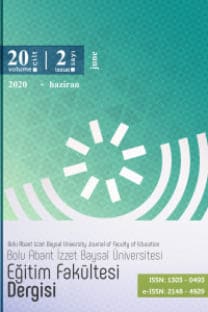KARESEL ATAMA İLE ÇOKLU REGRESYON VE LOJİSTİK REGRESYON SONUÇLARININ TEORİ ÇEŞİTLEMESİ KAPSAMINDA KARŞILAŞTIRILMASI
Karesel atama ile çoklu regresyon, lojistik regresyon, teori çeşitlemesi, PISA
COMPARISON OF MULTIPLE REGRESSION QUADRATIC ASSIGNMENT PROCEDURE’S AND LOGISTIC REGRESSION ANALYSIS’ RESULTS WITHIN THE SCOPE OF THEORY TRIANGULATION
Multiple regression quadratic assignment procedure, logistic regression, theory triangulation, PISA,
___
- Baker, F. B., & Hubert, L. J. (1981). The analysis of social interaction data: A nonparametric technique. Sociological Methods and Research, 9(3), 339-361. https://doi.org/10.1177/004912418100900305
- Cohen, L., Manion, L., & Morrison, K. (2011). Research methods in education (7th ed.). Routledge.
- Coleman, J. S. (1968). The concept of equality of educational opportunity. Harvard Educational Review, 38(1), 7-22. https://doi.org/10.17763/haer.38.1.m3770776577415m2
- Çokluk, Ö., Şekercioğlu, G. & Büyüköztürk, Ş. (2021). Sosyal bilimler için çok değişkenli istatistik: SPSS ve LISREL uygulamaları (6. baskı). Pegem Akademi.
- Dekker, D., Krackhardt, D., & Snijders, T. A. B. (2003, June 22-25). Multicollinearity robust QAP for multiple regression [Paper Presantation]. Annual Conference of the North American Association for Computational Social and Organizational Science, Pittsburgh.
- Dekker, D., Krackhardt, D., & Snijders, T. A. B. (2007). Sensitivity of MRQAP tests to collinearity and autocorrelation conditions. Psychometrika, 72(4), 563-581. https://doi.org/10.1007/s11336-007-9016-1
- Denzin, N. K. (1978). The research act: A theoretical introduction to sociological methods (2nd ed.). McGraw-Hill.
- Denzin, N. K. (1989). Interpretive biography. Sage.
- Denzin, N. K., & Lincoln, Y. S. (1994). Handbook of qualitative research. Sage.
- Efron, B., & Tibshirani, R. J. (1983). An introduction to the bootstrap. Chapman and Hall/CRC.
- Erlandson, D. A., Harris, E. L., Skipper, B. L., & Allen, S. D. (1993). Doing naturalistic inquiry: A guide to methods. Sage.
- Evans, G., & Rosenbaum, J. (2008). Self-regulation and the income-achievement gap. Early Childhood Research Quarterly, 23(4), 504-514. https://doi.org/10.1016/j.ecresq.2008.07.002
- Field, A. P. (2013). Discovering statistics using IBM SPSS Statistics: And sex and drugs and rock’n roll (4th ed.). Sage.
- Flick, U. (2002). An introduction to qualitative research (2nd ed.). Sage.
- Golafshani, N. (2003). Understanding reliability and validity in qualitative research. The Qualitative Report, 8(4), 597-606. https://doi.org/10.46743/2160-3715/2003.1870
- Güzeller, C. O., Eser, M. T., Aksu, G. (2016). UCINET ile sosyal ağ analizi. Maya Akademi.
- Honorone, J. (2017). Understanding the role of triangulation in research. Scholarly Research Journal for Interdisciplinary Studies, 4(31), 91-95.
- Hoque, Z., Covaleski, M. A., & Gooneratne, T. N. (2013). Theoretical triangulation and pluralism in research methods in organizational and accounting research. Accounting, Auditing and Accountability Journal, 26(7), 1170-1198. https://doi.org/10.1108/AAAJ-May-2012-01024
- Hubert, L. J. (1987). Assignment methods in combinatorial data analysis. Dekker.
- Jaccard, J. (2001). Interaction effects in logistic regression. Sage.
- Kleinbaum, D. G., & Klein, M. (2002). Logistic regression: A self-learning text (2nd ed.). Springer.
- Knox, H., Savage, M., & Harvey, P. (2006). Social networks and the study of relations: Networks as method, metaphor and form. Economy and Society, 35(1), 113-140. https://doi.org/10.1080/03085140500465899
- Krackhardt, D. (1987). QAP Partialling as a test of spuriousness. Social Networks, 9(2), 171-186. https://doi.org/10.1016/0378-8733(87)90012-8
- Krackhardt, D. (1988). Predicting with networks: Nonparametric multiple regression analyses of dyadic data. Social Networks, 10(4), 359-382. https://doi.org/10.1016/0378-8733(88)90004-4
- Krackhardt, D., & Kilduff, M. (1999). Whether close or far: Perceptions of balance in friendship networks in organizations. Journal of Personality and Social Psychology, 76(5), 770–782. https://doi.org/10.1037/0022-3514.76.5.770
- Mantel, N. (1967). The detection of disease clustering and a generalized regression approach. Cancer Research, 27(2), 209–220.
- Mertens, D. M., & Hesse-Biber, S. (2012). Triangulation and mixed methods research: Provocative positions. Journal of Mixed Methods Research, 6(2), 75-79. https://doi.org/10.1177/1558689812437100
- Nagelkerke, N. J. D. (1991). A note on the general definition of the coefficient of determination. Biometrika, 78(3), 691-692. https://doi.org/10.1093/biomet/78.3.691
- Nelson, R. E. (1989). The strength of strong ties: Social networks and intergroup conflict in organizations. Academy of Management Journal, 32(2), 377–401. https://doi.org/10.5465/256367
- O’Connell, A. A. (2006). Logistic regression models for ordinal response variables. Sage.
- Sokal, R. R., & Oden, N. L. (1991). Spatial Autocorrelation Analysis as an Inferential Tool in Population Genetics. The American Naturalist, 138(2), 518-521.
- Organisation for Economic Co-operationand Development (OECD). (2015). PISA 2015 technical report. http://www.oecd.org/pisa/data/2015-technical-report/
- Patton, M. Q. (2002). Qualitative research and evaluation methods (3rd ed.). Sage.
- Pitre, N. Y., & Kushner, K. E. (2015). Theoretical triangulation as an extension of feminist intersectionality in qualitative family research. Journal of Family Theory & Review, 7(3), 284-298. https://doi.org/10.1111/jftr.12084
- Riles, A. (2001). The network inside out. University of Michigan Press.
- Sarantakos, S. (2000). Social research. MacMillan.
- Sperandei, S. (2014). Understanding logistic regression analysis. Biochemia Medica, 24(1), 12–18. https://doi.org/10.11613/BM.2014.003
- Streiner, D. L. (1994). Figuring our factors: The use and misuse of Factor analysis. The Canadian Journal of Psychiatry, 39(3), 135-140.
- Yin, R. K. (2003). Case study research design and methods (3th ed.). Sage.
- ISSN: 1303-0493
- Yayın Aralığı: 4
- Başlangıç: 2000
- Yayıncı: Abant İzzet Baysal Üniversitesi Eğitim Fakültesi
SOSYAL BİLGİLER ÖĞRETİMİNDE METAFORLARIN KULLANIMI ÇERÇEVESİNDE DERS KİTAPLARININ İNCELENMESİ
Ünsal BEKDEMİR, Pınar TAĞRİKULU, Elif Omca ÇOBANOĞLU
ÖĞRETMENLERİN DAVRANIŞSAL GÜÇLENDİRİLMESİ İLE ÖRGÜTSEL ADANMIŞLIKLARI ARASINDAKİ İLİŞKİ
YÜKSEKÖĞRETİMDEKİ GENÇ YETİŞKİNLER İÇİN SOSYAL MEDYA YETERLİK ÖLÇEĞİNİN TÜRKÇEYE UYARLANMASI
ÖĞRETİM DİLİ OLARAK İNGİLİZCE: ÖĞRETİM ELEMANLARININ GÖRÜŞLERİ
TÜRKİYE’DE MÜZİK ÖĞRETMENİ ADAYLARININ MÜZİK ÜZERİNE FELSEFİ TERCİHLERİ: BİÇİMSEL VE / VEYA DUYUMSAL
